COLLECTIONS / Manuscripts, Codices, Early Printed Books, Engravings and Drawings
The Byzantine Museum owns at least 500 Byzantine and post-Byzantine manuscripts, dating from the 6th to the 19th century.
These are of exceptional interest not only because of their content but also because they provide invaluable information on the history and use of the manuscript book, and on the development of script, illustration and bookbinding.
The Early Printed Books of the Museum, about 300 in number, were printed between 16th and 19th c. in the most important printing houses in Venice, Balkan Peninsula and Central Europe. These publications show clearly that the Greek intellectuals of the Diaspora played a decisive role in creating the publishing industry in Europe and the Balkans in the early decades of the sixteenth century, and hence in the spread of intelligentsia in these areas.
The Museum’s Engravings Collection contains more than 600 woodcuts, etchings, lithographs, chromolithographies, and printed antimensia dated in 18th and 19th c. The collection documents the widespread circulation of prints during this period, especially in the Balkans, as well as their close relationship with contemporary painting.
Of particular importance is also the Museum’s Collection of Drawings, which includes more than 3200 works on paper. This contains, inter alia, ensamples of sketches by painters that were noteworthy exponents of the Nazarene painting in Greece in the second half of the 19th century, like Ludwig August Johann Thiersch and Spyridon Chatzigiannopoulos. The Collection also includes anthibola, working sketches (ink, pencil, charcoal on paper, sometimes also coloured) made by post-Byzantine painters that are dated between the 17th and 19th century.
Gallery View
-
 Chrysobull issued by Andronikos II Palaiologos
The chrysobull was issued by Andronikos II Palaiologos (1282-1328) to confirm and extend a number of privileges that he had g...
Chrysobull issued by Andronikos II Palaiologos
The chrysobull was issued by Andronikos II Palaiologos (1282-1328) to confirm and extend a number of privileges that he had g... -
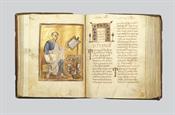 Lectionary
Lectionary, on parchment, of the 11th c. with later additions in paper and parchment. From the Church of Saint Gregory of Nys...
Lectionary
Lectionary, on parchment, of the 11th c. with later additions in paper and parchment. From the Church of Saint Gregory of Nys... -
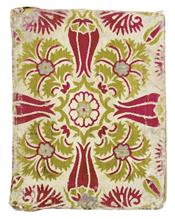 Evangelistarion (Lectionary)
Parchment Lectionary with decorated initials and headpieces. Later notes added to the manuscript indicate that it was used co...
Evangelistarion (Lectionary)
Parchment Lectionary with decorated initials and headpieces. Later notes added to the manuscript indicate that it was used co... -
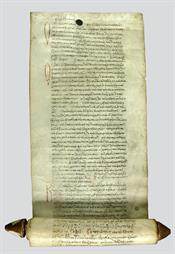 Divine Liturgy of Saint Basil
The parchment manuscript with the text of the Divine Liturgy of Saint Basil is a representative scroll sample of the Byzantin...
Divine Liturgy of Saint Basil
The parchment manuscript with the text of the Divine Liturgy of Saint Basil is a representative scroll sample of the Byzantin... -
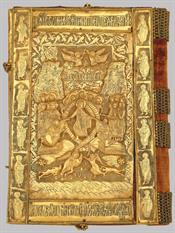 Manuscript Gospel
The luxurious manuscript with the equally luxurious binding was a gift from the voyvod of Wallachia, John Matthew Bassaraba a...
Manuscript Gospel
The luxurious manuscript with the equally luxurious binding was a gift from the voyvod of Wallachia, John Matthew Bassaraba a... -
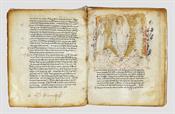 Manuscript (Gospel) fragment
Manuscript (Gospel) fragment, second half of the 12th c. A donation from Bishop David of Naupaktia to the Christian Archeolog...
Manuscript (Gospel) fragment
Manuscript (Gospel) fragment, second half of the 12th c. A donation from Bishop David of Naupaktia to the Christian Archeolog... -
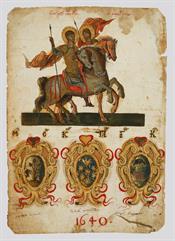 Saints Theodores (Stratelates and Teron) and Crests
A single leaf (paper), with a depiction of Saints Theodores (Stratelates and Teron) and three coats of arms, of Manolis Sofia...
Saints Theodores (Stratelates and Teron) and Crests
A single leaf (paper), with a depiction of Saints Theodores (Stratelates and Teron) and three coats of arms, of Manolis Sofia... -
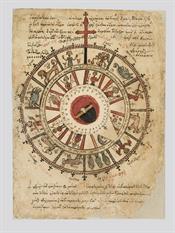 Paper construction with information for the move of the sun and the moon
Paper construction with information for the move of the sun and the moon during the year. Two rotating card discs have been a...
Paper construction with information for the move of the sun and the moon
Paper construction with information for the move of the sun and the moon during the year. Two rotating card discs have been a... -
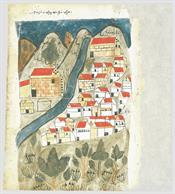 Depiction of the village Tserkouvitsa
Paper leaf with the depiction of the village Tserkouvitsa, built next to a river
Depiction of the village Tserkouvitsa
Paper leaf with the depiction of the village Tserkouvitsa, built next to a river -
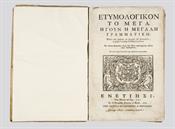 The Great Etymologicon, or the Great Grammar Book
This is an exceptionally rare edition of an important work, whose first edition (editio princeps) in 1499, produced in Venice...
The Great Etymologicon, or the Great Grammar Book
This is an exceptionally rare edition of an important work, whose first edition (editio princeps) in 1499, produced in Venice... -
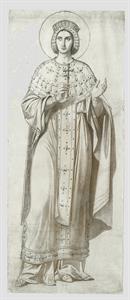 Saint
Saint, probably martyr; she is holding a cross in her right arm. Drawing by Ludwig Thiersch.
Saint
Saint, probably martyr; she is holding a cross in her right arm. Drawing by Ludwig Thiersch. -
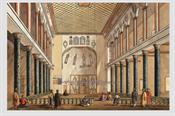 Stoudios Monastery (İmrahor Camii), interior.
The watercolour depicts Stoudios Monastery, one of the most important monasteries of Constantinople. The drawing shows the mo...
Stoudios Monastery (İmrahor Camii), interior.
The watercolour depicts Stoudios Monastery, one of the most important monasteries of Constantinople. The drawing shows the mo... -
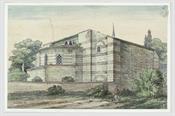 Stoudios Monastery (İmrahor Camii)
The watercolour depicts Stoudios Monastery, one of the most important monasteries of Constantinople. The drawing shows the mo...
Stoudios Monastery (İmrahor Camii)
The watercolour depicts Stoudios Monastery, one of the most important monasteries of Constantinople. The drawing shows the mo... -
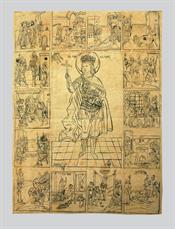 Sketch (ink) with St Gobdelaa and scenes of his life
“Anthibola” (working sketches), designed to help reproduce iconographic subject matter, are as much part of the tools of trad...
Sketch (ink) with St Gobdelaa and scenes of his life
“Anthibola” (working sketches), designed to help reproduce iconographic subject matter, are as much part of the tools of trad... -
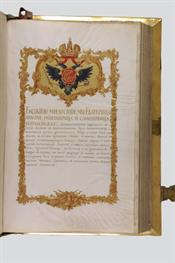 Gospel with a silver-guilt cover
The Gospel was printed in Moscow. It has a precious silver-guilt cover. In the front side of it, in high relief is the interi...
Gospel with a silver-guilt cover
The Gospel was printed in Moscow. It has a precious silver-guilt cover. In the front side of it, in high relief is the interi... -
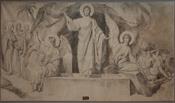 The Resurrection
Drawing (charcoal and pencil) depicting the Resurrection. Painted by the German artist Ludwig Thiersch. It was given by him t...
The Resurrection
Drawing (charcoal and pencil) depicting the Resurrection. Painted by the German artist Ludwig Thiersch. It was given by him t... -
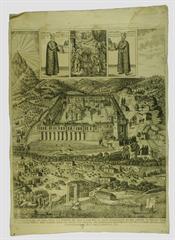 Philotheou Monastery, Mount Athos.
Copper engraving coming from Moscow and dated in 1849. The monastery is depicted in detail, and extends from the top of Mount...
Philotheou Monastery, Mount Athos.
Copper engraving coming from Moscow and dated in 1849. The monastery is depicted in detail, and extends from the top of Mount... -
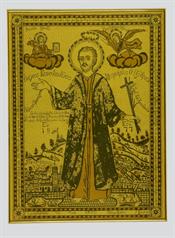 Saint Konstantinos from Hydra
Chromolithograph. St Konstantinos who was martyred in Rhodes in November 11th, 1800, is depicted in full body in front of the...
Saint Konstantinos from Hydra
Chromolithograph. St Konstantinos who was martyred in Rhodes in November 11th, 1800, is depicted in full body in front of the... -
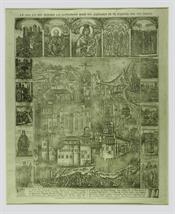 Docheiariou Monastery, Mount Athos.
Copper engraving, 1819. The monastery is depicted in great detail, while the sea is full of large sailboats and other ships. ...
Docheiariou Monastery, Mount Athos.
Copper engraving, 1819. The monastery is depicted in great detail, while the sea is full of large sailboats and other ships. ... -
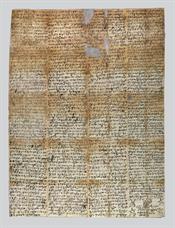 Paper leaf with handwritten blessings and magic symbols
Manuscript with apotropaic words and symbols. It was used like a bracelet.
Paper leaf with handwritten blessings and magic symbols
Manuscript with apotropaic words and symbols. It was used like a bracelet.
Comments
Users must be registered and logged in to comment.
No comments found.